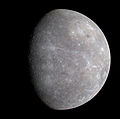Файл:Mercury in color - Prockter07 centered.jpg

Памер папярэдняга прагляду: 605 × 600 пікселяў. Іншыя разрозненні: 242 × 240 пікселяў | 484 × 480 пікселяў | 775 × 768 пікселяў | 1 033 × 1 024 пікселяў | 1 991 × 1 974 пікселяў.
Арыгінальны файл (1 991 × 1 974 кропак, аб’ём файла: 1,72 MB, тып MIME: image/jpeg)
Гісторыя файла
Націснуць на даце з часам, каб паказаць файл, якім ён тады быў.
| Дата і час | Драбніца | Памеры | Удзельнік | Тлумачэнне | |
|---|---|---|---|---|---|
| актуальн. | 15:49, 4 чэрвеня 2008 |  | 1 991 × 1 974 (1,72 MB) | Papa Lima Whiskey | {{Information |Description=Full color image of from first MESSENGER flyby |Source=NASA/JPL [http://messenger.jhuapl.edu/gallery/sciencePhotos/image.php?page=1&gallery_id=2&image_id=143] |Date=2008-01-30 |Author=NASA/[[w:Applied Physics Laborato |
Выкарыстанне файла
Наступныя 14 старонак выкарыстоўваюць гэты файл:
- BepiColombo
- Зрушэнне перыгелія Меркурыя
- Каланізацыя Меркурыя
- Меркурый
- Праходжанне Меркурыя па дыску Сонца
- Спадарожнік Меркурыя
- Спіс аб’ектаў Сонечнай сістэмы па памерах
- Спіс уступаў на Меркурыі
- Толкін (кратар)
- Шаблон:Выбраны змест/Меркурый
- Шаблон:Добрыя артыкулы
- Шаблон:Меркурый
- Партал:Астраномія
- Партал:Астраномія/Навігацыя
Глабальнае выкарыстанне файла
Гэты файл выкарыстоўваецца ў наступных вікі:
- Выкарыстанне ў ab.wikipedia.org
- Выкарыстанне ў af.wikipedia.org
- Выкарыстанне ў ang.wikipedia.org
- Выкарыстанне ў anp.wikipedia.org
- Выкарыстанне ў an.wikipedia.org
- Выкарыстанне ў ar.wikipedia.org
- عطارد
- كوكب
- ويكيبيديا:هل تعلم
- بوابة:المجموعة الشمسية
- مارينر 10
- بيبيكولومبو
- قالب:عطارد
- عبور عطارد
- قالب:المجموعة الشمسية
- قائمة أجرام المجموعة الشمسية مرتبة حسب الحجم
- قائمة أجرام النظام الشمسي المستديرة بالجاذبية
- ويكيبيديا:هل تعلم/قائمة/68
- حوض كالوريس
- برنامج مارينر
- اكتشاف واستكشاف النظام الشمسي
- قائمة أنواع الكواكب
- مستخدم:محمد 19951/ملعب13
- عبور عطارد من الزهرة
- عبور الشمس
- بوابة:المجموعة الشمسية/قوالب
- جيولوجيا عطارد
- استكشاف عطارد
- مستخدم:ASammour/صور مختارة
- ويكيبيديا:هل تعلم/قائمة شاملة
- حقل عطارد المغناطيسي
- 1981 ميداس
- حفرة فلايانو
- قالب:بذرة كوكب عطارد
- غلاف عطارد الجوي
- عطارد في الخيال
- Выкарыстанне ў ar.wiktionary.org
- Выкарыстанне ў arz.wikipedia.org
- Выкарыстанне ў ast.wikipedia.org
- Выкарыстанне ў as.wikipedia.org
- Выкарыстанне ў avk.wikipedia.org
- Выкарыстанне ў awa.wikipedia.org
- Выкарыстанне ў bat-smg.wikipedia.org
- Выкарыстанне ў ba.wikipedia.org
Паказаць глабальнае выкарыстанне гэтага файла.





